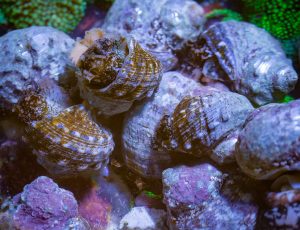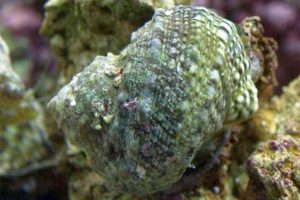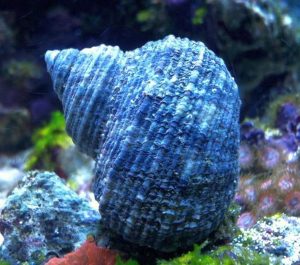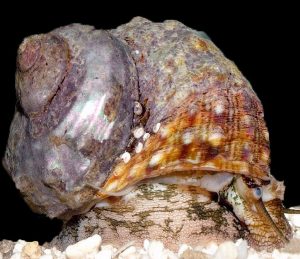The Mexican Turbo Snail (Turbo fluctuosa, Turbo fluctuosus) known to tropical fish keeping enthusiasts as the Turban snail, Mexican Turbo Grazer, Trochus Snail, Gulf Turban, Eastern Pacific Turban, Wavy Turban, or Top Shell Snail is a ravenous algae eater native to the Gulf of California off the coast of Mexico. Their range extends from Cedros Island, Baja California to Peru; including the Galapagos and Tres Marias Islands.
Mexican turbo snails are commonly found in the intertidal zones of their range, under and attached to rocks and dead corals where new growths of fresh algae are most abundant. They inhabit both mud and sandy substrates among moderately exposed coral reef shores where they shelter from predators among the crevices and boulders of their preferred habitat.
Although the optimum depth for Mexican Turbo Snails is from 2 to 33 feet, they are frequently collected as deep as 40 feet.
Juvenile Turbo fluctuosa prefer living in the sandy bottom substrates of the shallower intertidal reef flats, and in the fine rubble bottoms near growths of moderately exposed corals.
The Mexican Turbo Snail has a thick, domed, spiral shaped shell that consists of five rounded (with angled shoulder) whorls, and can grow to over 2 inches in size. The base is slightly convex with an oval operculum. Their eyes (detect motion and light) are located directly behind their two small tentacles.
Although Mexican Turbo Snails are found in a variety of colors; reddish brown, light brown, orange, olive green, orange with white/cream and dark brown mottling are the most common.
Mexican Turbo Snails are gonochoric (separate male and female individuals), without any external sexual dimorphism.
Mexican Turbo Snails (Turbo fluctuosa, Turbo fluctuosus) are excellent scavengers that have a ravenous appetite for algae, especially hair algae. They are highly esteemed by tropical fish keeping enthusiasts for their service as “clean up crew” members and are one of the most popular marine snails in the hobby.
Although Turbo fluctuosa, Turbo fluctuosus are not very shy; they are peaceful, slow moving, and non aggressive. When attacked by aggressive fish or crabs, they simply hunker down inside their shell or bury themselves in the sand.
The reef safe Mexican Turbo Snail is best housed in a well established reef aquarium with a sandy or fine gravel substrate and plenty of aged live rock arranged into hiding places with sufficient room for them to roam and graze on. In addition to being the best algae eaters and scavengers in the hobby, these snails are great at aerating the sandy substrate in your tank.
They also do well in a live rock fish only tank with peaceful tank mates like dwarf shrimp and small, non carnivorous fish.
Mexican Turbo Snails are compatible with Pederson Cleaner Shrimps, Sexy Shrimp, Red Fire shrimp (Lysmata debelius), Peppermint shrimp (Lysmata wurdemanni), Skunk Cleaner shrimp (Lysmata amboinensis), and snails like Bumble Bee Snail, Fighting Conch Snail, Cerith snails, Margarita snails (Margarites pupillus), Astrea Turbo Snails, Trochus Snails, etc.
Mexican Turbo Snails are frequently sold as members of clean up crews that will remove algae and clean the aquarium glass in your tank. Because of their large adult size, they are not good climbers like other smaller shelled species. Like Astrea snails, Mexican Turbo snails have a hard time righting themselves once they are knocked upside down and often need help from their owners. This is why they should not be housed with orange Claw Hermit Crabs (Calcinus tibicen). These crabs have a preference for occupying Astraea and Mexican Turbo snail shells, making them easy prey for an upside down snail. Coral banded shrimp can also be a bit too dangerous for these snails.
The Mexican Turbo Snail is a nocturnal species that becomes most active during low light and night time conditions. Their grazing activity picks up at dusk, continues throughout the night, and stops just before dawn. They will start grazing in the tank after the lights are turned off and regardless of the time of day, become active a few hours after being kept in darkness. Despite their slow moving pace, they cover surprisingly large areas in their search for algae during their foraging activities.
Juveniles and smaller specimens are better climbers and usually more active than adults.
Like other invertebrates, the Mexican Turbo Snail is sensitive to copper and high nitrate levels. Like all marine fish, they require slow acclimation over 2 to 3 hours using the drip method.
The Mexican Turbo Snail is a broadcast spawner that reaches reproductive maturity at 6 – 8 months with fertilization taking place in the water column at night . The male initiates spawning and the female spawn in response to the presence of seed in the water. (Click Here) Females release over a million unfertilized eggs (oocytes) over a period of 5 to 10 minutes. The eggs are fertilized (contaminated) with a transparent mucus, floating in the seawater that will eventually clear up in the tank. Corals and other filter feeders quickly eat the particles that cloud the water.
Hatching occurs approximately 12 to 24 hours after fertilization, after the larvae reach the planktonic phase. The larvae come out as free swimming veligers and remain so for approximately 3 to 5 days before settling onto the reef substrate to begin grazing on fine filamentous algae and microorganisms.
The snail larvae gradually metamorphose to the crawling stage in 6 to 8 days.
The mortality rate for the fertilized eggs is very high and only a few will survive to become adults.
Fertilization, larval development, and larval metamorphosis is suppressed at salinities lower than 30‰.
In their natural habitat, Mexican Turbo Snails prefer feeding on algae and seaweed as well as cyanobacteria and diatoms in the sand. In an aquarium environment, they will feed on hair algae, slime (filamentous) algae, brown macroalgae, diatoms, cyanobacteria as well as any leftover shrimp or fish foods pellets, flakes, Spirulina wafers
, frozen foods, etc. in the tank.
When sufficient food levels are not present in the aquarium, supplement their diet with vegetable based tablets or flake foods.
The Mexican Turbo Snail (Turbo fluctuosa, Turbo fluctuosus) is a common saltwater species that can be purchased almost anywhere at a cost of less than $1.00 to $5.00 each, at purchase sizes between 3/4″ to 2″. They are frequently sold online to tropical fish keeping enthusiasts as members of “cleanup crews” for reef tanks at even lower prices.
Due to the extreme heat in Mexico from July to September, Turbo fluctuosa are not normally harvested and are often not available for purchase. Astraea Turbo Snails (Lithopoma tectum) or the more sensitive Margarita snails (Margarites pupillus) make ideal substitutes during these periods.
Minimum Tank Size: 10 gallons
Aquarium Type: Established Reef or LRFO
Care Level: Easy
Temperament: Peaceful
Aquarium Hardiness: Hardy
Water Conditions: 70-73°F, dKH 8 to 16, pH 8.1-8.4, sg 1.023-1.025
Max. Size: 2″
Color Form: Light brown, reddish-brown, greenish, or orange with whitish and dark brown mottling
Diet: Specialty Herbivore
Compatibility: Reef Compatible
Origin: Caribbean Sea, Gulf of Mexico, Lesser Antilles
Family: Astraeinae
Lifespan: 3-5 years
Aquarist Experience Level: Beginner






